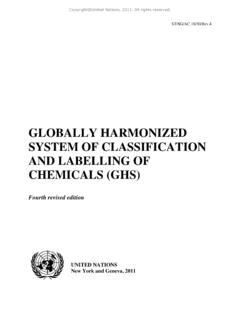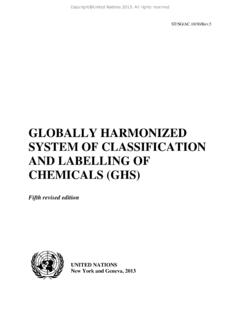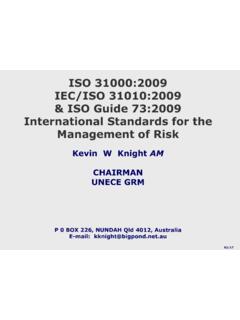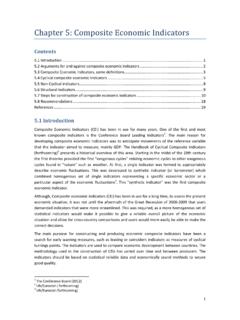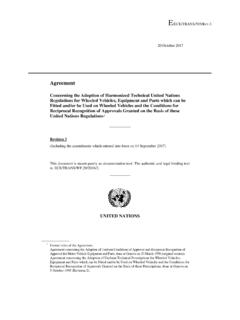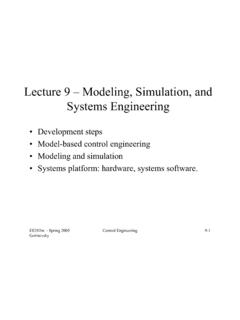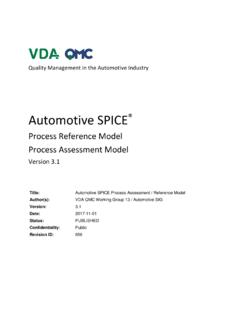Transcription of Addendum 20: Global Technical Regulation No. 20 - UNECE
1 ECE/TRANS/180 3 May 2018. Global Registry Created on 18 November 2004, pursuant to Article 6 of the Agreement concerning the establishing of Global Technical regulations for wheeled vehicles, equipment and parts which can be fitted and/or be used on wheeled vehicles (ECE/TRANS/132 and ) done at Geneva on 25 June 1998. Addendum 20: Global Technical Regulation No. 20. Global Technical Regulation on the Electric Vehicle Safety (EVS). Established in the Global Registry on 14 March 2018. UNITED NATIONS. (E).. ECE/TRANS/180 Global Technical Regulation on Electric Vehicle Safety (EVS).
2 Contents Page I. Statement of Technical rationale and .. 7. A. Introduction .. 7. B. Procedural background .. 7. C. Technical background .. 8. D. Principle for developing the Global Technical Regulation .. 14. E. Technical rationale and justification .. 16. F. 57. G. Existing regulations , directives, and international voluntary standards .. 58. H. Benefits and costs .. 61. II. Text of Regulation .. 63. 1. Purpose .. 63. 2. Scope .. 63. 3. Definitions .. 64. 4. General requirements .. 67. 5. performance requirements .. 68. Requirements of a vehicle with regard to its electrical safety - in-use.
3 68. Protection against electric 68. Functional 71. Requirements of a vehicle with regard to its electrical safety - post-crash .. 72. General principle .. 72. Protection against electric shock .. 72. Requirements with regard to installation and functionality of rechargeable electrical energy storage system (REESS) in a vehicle .. 74. Installation of REESS on a vehicle .. 74. Warning in the event of operational failure of vehicle controls that manage REESS safe operation .. 74. Warning in the case of a thermal event within the REESS .. 74. Warning in the event of low energy content of REESS.
4 75. Requirements with regard to the safety of REESS - in-use .. 75. General principle.. 75. Vibration .. 75. Thermal shock and cycling .. 76. Fire resistance .. 76. 3. ECE/TRANS/180 External short circuit protection .. 76. Overcharge protection .. 76. Over-discharge 77. Over-temperature protection .. 77. Overcurrent protection .. 77. Low-temperature protection .. 78. Management of gases emitted from REESS .. 78. Thermal propagation .. 78. Requirements with regard to the safety of REESS - post-crash .. 80. Vehicle based test .. 80. REESS-component based test.
5 81. 6. Test procedures .. 82. Test procedures for electrical safety .. 82. Isolation resistance measurement method .. 82. Confirmation method for functions of on-board isolation resistance monitoring system .. 86. Protection against direct contact to live parts .. 87. Test method for measuring electric resistance .. 89. Test procedure for Protection against water effects .. 90. Test conditions and test procedure regarding post-crash .. 90. Test procedures for REESS .. 94. General procedures .. 94. Vibration test .. 95. Thermal shock and cycling test.
6 97. Fire resistance 98. External short circuit protection .. 102. Overcharge protection test .. 103. Over-discharge protection test .. 106. Over-temperature protection test .. 109. Overcurrent protection test .. 111. Mechanical shock test .. 112. Mechanical integrity test .. 114. 7. Heavy duty vehicles performance requirements .. 116. Requirements of a vehicle with regard to its electrical safety - in-use .. 116. Protection against electric shock .. 116. Functional 120. 4. ECE/TRANS/180 Requirements with regard to installation and functionality of REESS in a vehicle.
7 120. Installation of REESS on a vehicle .. 120. Warning in the event of operational failure of vehicle controls that manage REESS safe operation .. 121. Warning in the case of a thermal event within the REESS .. 121. Warning in the event of low energy content of REESS .. 122. Requirements with regard to the safety of REESS - in-use .. 122. General principle .. 122. Vibration .. 122. Thermal shock and cycling .. 122. Fire resistance .. 123. External short circuit protection .. 123. Overcharge protection .. 123. Over-discharge 123. Over-temperature protection.
8 124. Reserved .. 124. Low-temperature protection .. 124. Management of gases emitted from REESS .. 124. Thermal propagation .. 125. Requirements with regard to the safety of REESS simulating inertial load .. 126. Mechanical shock .. 126. 8. Heavy duty vehicles - Test procedures .. 127. Test procedures for electrical safety .. 127. Isolation resistance measurement method .. 127. Confirmation method for functions of on-board isolation resistance monitoring system .. 130. Protection against direct contact to live parts .. 131. Test method for measuring electric resistance.
9 133. Test procedure for Protection against water effects .. 134. Test procedures for REESS .. 135. General procedures .. 135. Vibration test .. 136. Thermal shock and cycling test .. 137. Fire resistance 138. External short circuit protection .. 142. Overcharge protection test .. 144. 5. ECE/TRANS/180 Over-discharge protection test .. 146. Over-temperature protection test .. 149. Reserved .. 151. Mechanical shock test .. 151. Annexes 1 Determination of hydrogen emissions during the charge procedures of the 154. Appendix 1: Calibration of equipment for hydrogen emission testing.
10 165. 2 Verification method for testing authorities confirming document based isolation resistance compliance of electrical design of the vehicle after water exposure .. 168. 6. ECE/TRANS/180 I. Statement of Technical rationale and justification A. Introduction 1. Electromobility represents the concept of using electric powertrain technologies with a view to address climate change, improve air quality and reduce fossil fuel dependency. The current regulatory pressure to lower CO 2 and pollutant emissions is helping to drive an increasing market penetration of vehicles utilizing electric powertrain (hereafter, "electrically propelled vehicles" or "EV").


